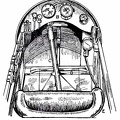Another machine which is stable in flight, owing to the peculiar formation of its wings, which resist a diving or plunging movement, or a lateral swing, is the Dunne biplane—as designed by Lieutenant J. W. Dunne. This craft is seen in the figure. Using such a machine, pilots have flown for long distances with the control levers locked, the biplane adapting itself automatically to the wind-gusts and preserving its equilibrium without aid of any kind. It has neither fore-plane nor tail; it is made to ascend by elevators which are in the form of hinged flaps, or ailerons, and is steered by two rudders at the extremities of the main-planes.
A. Hull containing pilot and passenger
B.B. Main-planes
C.C.C.C. Flaps used as elevators
D.D. Side-planes which act as rudders
E. Engine and propeller
F. Alighting gear.
- Author
- The Project Gutenberg eBook, The Aeroplane, by Claude Grahame-White and Harry Harper
Published 1914 - Posted on
- Tuesday 18 August 2020
- Dimensions
- 1200*576
- Tags
- Flight
- Albums
- Technology / Transport / Air
- Visits
- 619
- Downloads
- 29
 Download Photo
Download Photo





